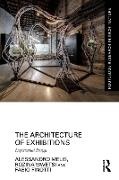Read more
The Architecture of Exhibitions embarks on a comprehensive exploration of creativity and design innovation within exhibition spaces. It describes the fundamental principles of exhibition design, tracing the origins of creativity and considering its evolutionary significance.
List of contents
Part 1 A New Perspective on the Origin of Art Exhibition 1. The Origin of the Design of Exhibition Space: From Cave Art to Göbekli Tepe 2. Art Exhibition from the Classic Perspective 3. An Historical Perspective of Architecture for Art Exhibition
Part 2 Present and Future Scenarios for Art Exhibition 4. Graphic Narratives for Social Transformation: Weaving Stories into the Built Environment 5. Future Developments 6. Community Resilience at the Venice Biennale (2021-2023)
Part 3 Practice-Based Research in Contemporary Art Exhibition 7. Art Exhibition: Guest Contributions, Case Studies, Professional and Academic Experiences
Part 3.1 Innovations and Challenges in Traditional Art Exhibition Settings: Guest Contributions 8. Meta-Exhibition Designs 9. The Architecture of Exhibitions and the Exhibition of Architectures: What Are We "Left" With? 10. The Tyranny of Distance?
Pa t 3.2 Interdisciplinary Innovations and Immersive Experiences 11. Components, Representations, and Pixels: Three-Dimensional Resolution Through Digital Fabrication 12. Stereoma: Designing an Immersive Spatial Experience 13. Field Notes from My Little Aurora: Close Encounters of the Robotic Kind. Enacting Human-Robot Coexistence in Everyday Life Performing Spaces 14. Marmomac Meets Academies: The Greatest Show of Stone Experimentation 15. Toward Non-Humans' Embassies
Part 3.3 The Social, Political, and Narrative Dimension of the Art Exhibition 16. 416_SR1938: The Presence of Memory in the Perceptual Experience 17. Holier Than Thou 18. Phygital: A Designer's Call to Action 19. Enhancing the Sense of Place Through Performative Arts: The Case of Venice 20. Visual Voices: Female-Themed Murals as Community Exhibitions in the South Bronx 21. Gravitational Waves Architecture: Architecture as a Tool for the Transmission of Scientific Knowledge
Part 4 Conclusion 22. Reflection and Conclusion on the Evolution and Innovation of Exhibition Spaces 23. Handbook: Designing Exhibition Spaces
About the author
Alessandro Melis is a distinguished architect and art curator who currently holds the prestigious position of the first Endowed Chair Professor at the New York Institute of Technology. He was appointed by the Italian Minister of Culture as the curator of the Italian Pavilion at La Biennale di Venezia in 2021 and was honored as an ambassador of Italian Design in 2020-2024 (Italian Ministry of Foreign Affairs).
Rozina Vavetsi is Associate Professor at New York Tech, an award-winning visual designer and a Fulbright U.S. Scholar. With over two decades of experience in higher education, she combines forward-thinking pedagogy with invaluable industry expertise, demonstrating a strong commitment to bridging the gap between academia and the professional design world. Professor Vavetsi inspires her students to push disciplinary boundaries, emphasizing research, the exploration of emerging technologies, and creative problem-solving. She teaches a diverse array of design courses at both the graduate and undergraduate levels, maintains an active freelance career, and frequently participates in international conferences to stay abreast of idea exchanges and developments in the design landscape. Her design work has been featured in prestigious publications and exhibited in various venues around the world. Professor Vavetsi's research interests include typography, information design, environmental graphic design, design thinking, human-centered design, and participatory design.
Fabio Finotti, an Emeritus Professor at the University of Pennsylvania, held the prestigious Mariano DiVito Chair of Italian Literature. Additionally, Finotti's leadership extends to his role as the President of the Interuniversity Master's Degree in Italian Studies, a collaborative program between the University of Trieste and the University of Udine. Appointed by the Italian Government, Finotti has been the Director of the Italian Institute of Culture in New York since 2020.
Summary
The Architecture of Exhibitions embarks on a comprehensive exploration of creativity and design innovation within exhibition spaces. It describes the fundamental principles of exhibition design, tracing the origins of creativity and considering its evolutionary significance.

